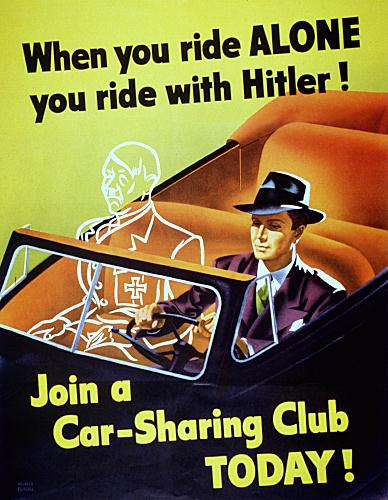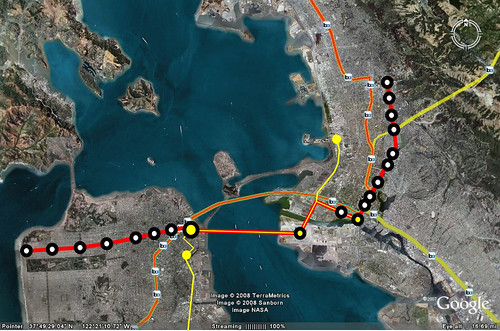Saturday, January 19, 2008
Oil Money Buys Rail Transit
Friday, January 18, 2008
That Sounds Kinda Expensive
It will also allow any further light rail expansion to the east side and create a second river crossing for light rail which would be important should one of the bridges go down in the chance of an earthquake. This is all about expanding the network as Metro Councilor Robert Liberty States.
As Liberty sees it, completing the Portland-to-Milwaukie line will keep the promise of the original system and open up new possibilities, including an extension to Oregon City and east-west connections that do not pass through downtown Portland.As I think further about this and look at the distance, even with the bridge section, 6.5+ miles at a billion dollars seems like a lot of money. It works out to around $150 million per mile (without the bridge section costs). Are they building a trench for it? Is it a subway? Especially since the Yellow Line was under budget and $60 million per mile in 2004. Folks at Portland Transport are commenting on this as well. I wonder what costs so much? Specifically after the Portland folks have gotten good at the track work after the Streetcar and Yellow Line. We really need to reign in these cost issues or new lines will never be built. I believe thats what the opposition wants, as well as our very best friends in Washington DC. Perhaps its time for the rapid streetcar but we'll figure out what is behind the costs soon.
Thursday, January 17, 2008
Seattle Action Alert!
Wednesday, January 16, 2008
When You Ride With...

Tuesday, January 15, 2008
Mary Peters Says...
Some of the transit investments are not based on a strict benefit-cost analysis. The estimates for rail passenger investment needs ($7 - $9 billion per year, of which over $6 billion would be Federal grants) are similarly unrealistic. It is not clear that even our current investments in passenger rail yield benefits in excess of their costs; it is highly unlikely that $9 billion per year in cost-beneficial investment opportunities in passenger rail could be found.She's right about one thing. Most transit investments aren't based on a benefit-cost analysis, today they are based on the Cost Effectiveness measure which does not measure many benefits of transit including economic development even though they have been asked many times by Congress to do so. It's funny that they don't ask any roads to go through such rigor. Is there a cost effectiveness measure for roads? No.
Unrealistic? I have a whole list of valuable projects here that could use funding. This shows how reality is lost on the current administration in terms of transportation investments and importance. I know that many of you would love to be able to compete for $6 Billion a year versus the current $1.6 B. Much of that money goes to larger cities as well such as New York (which i think should keep getting funding), but the new starts pipeline is said to be 50 years long. You can't tell me that the FTA couldn't use more funding for projects. In fact that is what people around the country have been asking for!
And in sure Bushy fashion, here is what they would do in writing if they had control (wait, right now they do). All highways all the time.
As is evident from the preceding observations, we would advocate a substantially different approach than that proposed by the Commission Report. Our approach would sustain current gasoline and diesel tax levels and refocus Federal efforts onTomorrow I'll talk about the majority recommendations in the report.
(a) maintaining the Interstate Highway System;
(b) alleviating freight-related bottlenecks that impede the flow of commerce and goods; and
(c) providing States with appropriate analysis, incentives, and flexibility regarding the adoption
of market-based reforms to their highway systems.
Monday, January 14, 2008
Covering the Transportation Peep from Candidates
Hmm choices don't seem so bad to people now...The remark was all but ignored by the Democratic front-runners, and was greeted by pundits with praise or disdain, depending upon their ideological stripe, before being once again set aside in favor of discussion on sexier issue areas.
But Richardson had hit upon a truly pressing matter, one which deserves the attention of federal policy makers. Transportation accounts for a third of all carbon dioxide emissions in this country. Moreover, concerns about gas prices, congestion, housing costs, and other related urban ills loom large in the lives of Americans, if not necessarily in political debates. We should be having a discussion about the way in which we build and grow our cities, the costs of our current approach, and what the federal government can do to fix what's broken.
And while commuters in New York and Chicago can shift (and have shifted, impressively) from driving to transit as gas prices rise, residents of autocentric towns in the south and west cannot, and are therefore forced to swallow high fuel costs. If the U.S. manages to adopt carbon limiting rules, as it should, long automobile commutes will become more expensive still; as such, the massive southward migration based on low-density development will make emission reductions more difficult and more painful. It may also make them less likely, since consumers will have a strong incentive to fight new costs they can't easily avoid.Our government has sold out to Detroit, even John McCain is telling them to suck it up, because as we all know, after the car, the horse and buggy market just wasn't the same. Apparently, Alex Smith's hat reference has caught on. From the Times UK:
This gnarled truth-teller of Republican politics — who says that he is “as old as dirt, with more scars than Frankenstein” — refuses to join Mr Romney in promising to save every job. Time moves on, Mr McCain suggests, just as it did for those working in “buggy-whip factories and haberdashers when cars replaced carriages and men stopped wearing hats”.
Sunday, January 13, 2008
Thinking Big: The Next Bay Area Project
But that isn't what i really wanted to talk about. I have a new idea for the Bay Area's newest New Start/Transit Project. I'd like to call it the Subway to the Sea 2, Urban Core Capacity Enhancement. The title is a nod to the Subway to the Sea bubbling up in LA and the New Jersey Access to the Core tunnel under the Hudson. If we're going to densify the bay area further, we need more of a metro system along major corridors. We need to be cost effective, so we should start with a corridor that would generate a lot of new ridership. So how about we build a line between the beach and downtown on Geary, build the new trans-bay tube that's been planned, and build up Broadway in Oakland to Rockridge and Berkeley under the 51 line.
Current ridership in this corridor is 56,000 for Geary and 18,600 boardings on the 51. This means that if everyone changed modes (which we know there still has to be a surface bus line for shorter trips) there could be about 80,000 riders. Given the speed of the new line and convenience it could increase ridership to way over 100,000 a day just on the line. This is a third of BART's ridership. Now the line is 19 miles from Berkeley to the Sea along the route I mentioned.
Now the line wouldn't just generate a lot of ridership, but it would generate a lot of new TOD, Office and Residential. In Oakland on Broadway, there would be a surge in new development along the corridor between College Avenue and Downtown. It's possible to capture a lot of the office and residential markets and take some pressure off of the outer sprawling suburbs. It will also take pressure off of the almost at capacity Transbay Tube.
Another feature of this would be the tunnel under the bay. it should be designed to be dual mode so that Caltrain/HSR could go to Oakland, Emeryville, and/or Jack London Square. That way Caltrain could extend into downtown and across the bay to Emeryville and possibly beyond making a connection between the jobs there and Silicon Valley (Yellow). It's possible to electrify the line all the way up to Martinez making commutes from around the horn easier with new stations in North Richmond and Hercules. It might also provide a way to keep trains away from Jack London which has had some issues with accidents. It would be a big project and more than likely cost a lot of money, but it will also be a huge ridership generator. Not only will you get over 100,000 from the subway alone, there will be the tens of thousands that want to get across the bay with a one seat ride to Emeryville and Jack London Square.

Saturday, January 12, 2008
Idea: LACMTA Turnstiles = Electricity
Another idea that came up this week sent to me by a colleague and friend was the ability to use excess body heat from subway stations to heat buildings. Sounds kind of gross to me, but if it works...
APTA Technical Document on Streetcars
Problems typically found on track of questionable design and/or construction are:
- Improper gauging of track and guard rails.
- Use of apparently railroad-based designs not suitable for Light Rail Circulator System rolling stock with street
- railway wheels and/or the curvature employed on the system. (See Figure 3.)
- Failure to understand the criticality of certain crucial track dimensions and tolerances under small radius circumstances.
- Employment of design details that increase the cost and complexity but have no payback in terms of performance or utility
Friday, January 11, 2008
Thinking Big in Raleigh-Durham
The Triangle can afford to expand bus service and build new rail projects if local leaders make a "Charlotte level of effort," the head of a regional transit agency said Friday.A new half-cent local sales tax could augment local and state transit funds to pay for 150 new buses in the next few years and launch more than $1 billion worth of capital projects by 2020, said David King, general manager of the Triangle Transit Authority.
